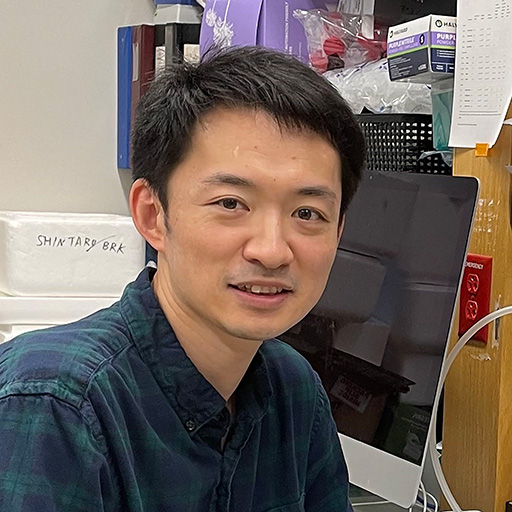Uncovering the Developmental Mechanism of Chorioretinal Anastomoses

Principal Investigator
Tyson Kim, MD, PhD
University of California, San Francisco
San Francisco, CA, USA
About the Research Project
Program
Award Type
Other
Award Amount
$450,000
Active Dates
July 01, 2021 - December 31, 2024
Grant ID
M2021015N
Mentor(s)
Douglas Gould, PhD, University of California, San Francisco
Aparna Lakkaraju, PhD, University of California, San Francisco
Dan Schwartz, MD, University of California, San Francisco
Goals
We investigate the developmental mechanism driving chorioretinal anastomoses (CRA) – lesions characterizing a challenging and often resistant subtype of neovascular age-related macular degeneration. The aims of our study are to (1) optimize an advanced imaging method to peer deep into the living eye with cellular resolution and the ability to measure microvascular blood flow; (2) employ this method in a genetic model of neovascular age-related macular degeneration (AMD) to characterize the arteriovenous identity and blood flow of CRA; and (3) to uncover the developmental origin of CRA. Completion of these aims will enable a broadly powerful imaging tool for the AMD research community and increase our fundamental understanding of a challenging form of neovascular AMD.
Summary
Age-related macular degeneration (AMD) is a leading cause of irreversible blindness, affecting approximately 196 million people worldwide. Neovascular AMD, an advanced form of disease characterized by abnormal blood vessel growth and dysfunction, accounts for only 10-20% of patients yet is responsible for 90% of legal blindness from AMD. A particularly challenging manifestation is development of vascular fusions between the retinal and choroidal vascular networks which enlarge into chorioretinal anastomoses (CRA). These lesions can be resistant to existing treatments and act as hot spots for recurring leakage and damage, resulting in debilitating vision loss. Our project seeks to uncover the developmental cause and molecular identity of CRA to find new therapeutic strategies for this challenging condition. In order to study the formation of CRA with mechanistic detail, we develop an advanced imaging method to peer deeper into the living eye with cellular resolution, molecular information, and the ability to measure blood flow down to individual microvessel. We apply this approach to image formation of CRA in a genetic model of neovascular AMD. Our work will give AMD researchers a powerful new tool to study the retina and choroid, and will provide insights into CRA to help develop more effective treatments for this challenging condition and neovascular AMD.
Unique and Innovative
A challenging subtype of neovascular age-related macular degeneration is distinguished by vascular proliferation in the retina and choroid resulting in chorioretinal anastomoses (CRA). CRA can be resistant to existing therapies and their developmental mechanism remains unknown. Our project has two major innovations: (1) we optimize a powerful approach for intravital imaging of chorioretinal vascular development and use this to study formation of CRA, and (2) we uncover a potentially novel role for arteriovenous identity and remodeling in the pathogenesis of CRA.
Foreseeable Benefits
Completion of this project will enable a powerful intravital imaging approach for studying chorioretinal biology and vascular dynamics which will be broadly useful to the age-related macular degeneration research community. Additionally, this project will uncover a potential role for arteriovenous identity and remodeling in the pathogenesis of chorioretinal anastomoses and neovascular age-related macular degeneration, helping to lay a conceptual framework for new therapeutic avenues for treatment-resistant disease.
Grants
Related Grants
Macular Degeneration Research
Innovative Night Vision Tests for Age-Related Macular Degeneration
Active Dates
July 01, 2024 - June 30, 2027

Principal Investigator
Maximilian Pfau, MD
Innovative Night Vision Tests for Age-Related Macular Degeneration
Active Dates
July 01, 2024 - June 30, 2027

Principal Investigator
Maximilian Pfau, MD
Macular Degeneration Research
The Development of a Transplant-Independent Therapy for RPE Dysfunction
Active Dates
July 01, 2024 - June 30, 2026

Principal Investigator
Shintaro Shirahama, MD, PhD
The Development of a Transplant-Independent Therapy for RPE Dysfunction
Active Dates
July 01, 2024 - June 30, 2026

Principal Investigator
Shintaro Shirahama, MD, PhD
Macular Degeneration Research
Immune Cell Traps in Inflammation and Wet Age-Related Macular Degeneration
Active Dates
July 01, 2023 - June 30, 2026

Principal Investigator
Matthew Rutar, PhD
Immune Cell Traps in Inflammation and Wet Age-Related Macular Degeneration
Active Dates
July 01, 2023 - June 30, 2026

Principal Investigator
Matthew Rutar, PhD



